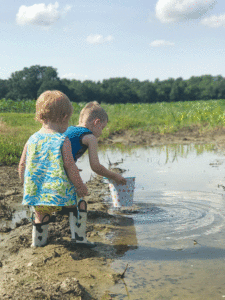The mudroom at the Milby household houses more than just a substantial amount of mud. 
Our delivery men have seen it all. This month, it’s a tadpole sanctuary.
This particular project started out how many do: Very innocently visiting family at their new home.
The pool had been vacant for a while and had turned into something of a wildlife refuge, complete with a snapping turtle and tadpoles galore.
Who am I to resist such a fun project? My husband of course, was saying, “we have hundreds in the back field,” which sounded like an exaggeration, if not an outright lie.
However, a field study done the next afternoon would show that sure enough, the massive amounts of rain lately left a puddle absolutely teeming with tadpoles in our back field.
For your own, you could also look along the edges of ponds and in temporary pools or puddles that will likely dry up deeper in the summer.
My small but mighty crew and I chose a small number from each spot, because like kids, it’s easier to keep track of just a few.
If you get too many you start calling the wrong name a few times until you land on the right one.
Also, the Department of Natural Resources requires you to have a permit if you possess more than 25 tadpoles of any species at one time.
While I definitely remember trying to catch tadpoles as a kid, I don’t recall the process, the food, or really any key parts to the miracle of metamorphosis, and so a quick trip to the library was on the immediate itinerary.
Tadpoles and frogs are quite the popular kids activity and there’s no shortage of books on them in the kids nonfiction section.
Just grab one that gives you facts and a good overview.
If I had older children, a great activity would be to sketch out the lifecycle, but alas, my daughter Lucy is the artist and prefers to color her legs and her brother.
The tadpoles from the pool, located near a creek, and the tadpoles from our back field were very different.
The ones found on our farm were darker, smaller and several had already developed their front and back legs, while the ones from the pool were more of the classic teardrop shapes.
According to Maryland’s DNR, there’s 20 species of frogs and toads in our area and based on their looks and the conditions of where we got them from, we could figure out what our new friends likely were from their website- http://dnr.maryland.gov.
Much to my son Landon’s disappointment, neither were the poisonous blue frogs we found in our readings, as blue is his favorite color.
We engineered our setup out of an old storage bin filled with distilled water (spoiled, I know) that was room temperature.
Really, any water you let adjust to room temperature should suffice as my husband, Mr. Sunshine, pointed out that the tadpoles had indeed originated from a puddle and a neglected pool.
We then gathered up any rocks we could find left in the driveway and some sticks that were longer to provide hiding spots and serve as an important and necessary spot where future froglets could climb out of the water and practice their land legs.
We also had a few large rocks that would sit out of the water for lounging.
Our mudroom was ideal for us as it provided both sunlight and some shade, but most importantly, a safe spot from curious paws, or worse, our dog LXZander drinking them by accident.
You could house your tadpoles outside, but make sure there is a shade for them to retreat to as desired.
I wasn’t due for Harris Teeter until the next day to purchase lettuce and spinach leaves and so I was worried our tadpoles would starve to death quite early on with their time at the Milbys.
I decided to boil & dice some of the large leafy weeds, and delightedly, the tadpoles loved it.
Leaves from the place they were caught or limited amounts of regular fish food flakes were other tadpole treats we did not use but research says work as well.
Upkeep was rather minimal. We fed our guys everyday and I did find that like others in the Milby household, these tadpoles were rather messy and so I’d do a total cleanout every four to five days.
We’d take a peek in the morning and see who’d gotten longer legs, who was hiding under a rock and if anyone was getting to the much anticipated “eating their tail stage.”
We looked at the leaves to see if they’d been really eating away, getting ready for the big transformation.
Knowing when to let the froglets go was trickier than I anticipated and likely similar to when I have to put Landon on the bus to Pre-K next fall.
Were they ready? Will they starve? Will they make any friends?
Once we noticed they were out of the water and using the lounging rocks more and wanted to hop, we decided they were ready.
We had a tearful goodbye at the same places we found them rejoined with their natural brothers and sisters.
We had a blast with our temporary mudroom guests, and it was a great learning project.
I know we will see the little guys again someday, maybe hiding in our boots when we go to slip them on.




